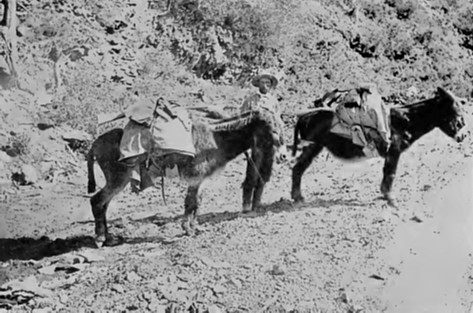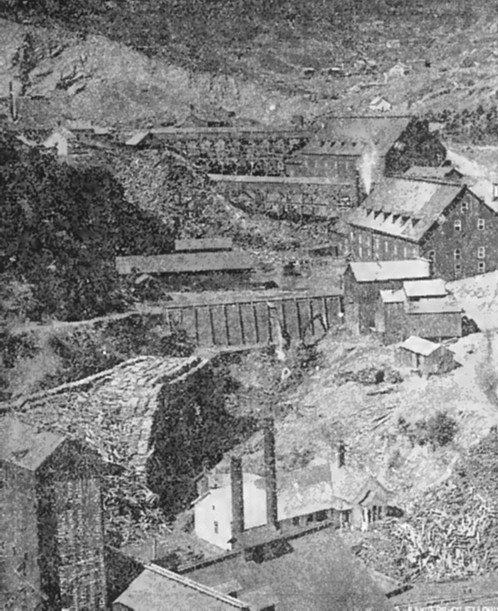This district produces some wonderfully rich native silver specimens, and in Strawberry Gulch, six miles out toward Deadwood, there are several promising mines. The Keystone, of this district, has produced ore assaying one hundred dollars per ton, has encountered a large body of ore ; much of the ore, however, is of low grade. From eight pounds of rock from this mine one of the hands is said to have taken out two dollars' worth of wire gold with his fingers from a piece of ore. The "Sunday Mine," of the same district, has opened up some fine specimens of gold-bearing quartz at a depth of one hundred and twenty feet. In cross-cutting seventy-five feet, twenty feet of ore were found to be quite rich. A forty-stamp mill has been erected at this mine. The Bald Mountain Silver District, south-west of Deadwood, is also attracting much attention. It would not be strange if the silver interests of the Black Hills, which are yet in their infancy, should prove of equal importance to her gold interests, and perhaps of even more permanent character. It seems hardly probable, however, that the generation now living will ever see her gold Bonanzas exhausted. Several mines in the Bald Mountain Silver District give high assays, among which are the Trojan Mine.
This mine is located on the north-eastern slope of Bald Mountain, and the trend of the vein points to the centre of the hill. It is in a formation of gneiss and porphyry, the foot-wall being porphyry and the hanging wall gneiss. The mine was discovered by Messrs. Smith, Keats, Blake and Crane, who, in 1878, believing there was something good in old Baldy, began to systematically prospect the mountain. Their task was difficult, the entire mountain's side being thickly covered with a dense growth of under-brush; but their perseverance was finally rewarded. The prospectors found "gold quartz float" rock at the base of the mountain. They traced it along up the mountain side to where it entirely gave out, and no more could be found any higher up. At this point they sunk a shaft through the debris into the solid rock, and at a depth of only fifteen feet from the surface they struck the Trojan lode.
Assays of the ore gave them encouragement, and the shaft was sunk to the depth of forty-five feet, the ore meanwhile becoming richer, both in silver and gold, as depth was attained. At this depth a large body of ore was encountered. The surface-water causing some annoyance, a tunnel was started at a lower point down the slope to reach the vein. The tunnel was run in over two hundred feet, the last one hundred feet being run in ore. At the head of the tunnel is a "face" of twenty-two feet, all solid ore, rich horn silver chlorides, and black argentite sulfides, and native silver, besides masses of ore impregnated with free gold. This mass of ore has been tested by mill process, and is said to average one hundred and fifty-five dollars per ton.
The Perseverance Mine is an extension of the Trojan on the south. It is opened by a tunnel two hundred and twenty feet long, in the face of which there are twenty feet of free milling gold and silver ore, which is said to mill nearly one hundred dollars per ton. The Decora Mine, a short distance from the Perseverance, is a gold quartz lode. It is opened by shafts and a tunnel to the depth of sixty-five feet. It shows free gold in abundance, and it is thought it will mill not less than twenty dollars per ton. The Empire Mine, lying contiguous to the Trojan, produces gold and silver quartz assaying from fifty to one thousand dollars per ton. It is opened by a shaft forty feet deep, from the bottom of which long drifts have been run on the vein. The Snow-Storm Mine, also on Bald Mountain, is another promising silver mine, and is erecting a silver mill to reduce its ore.
The Portland Mine, also in the same locality, is erecting a silver mill to cost seventy thousand dollars ; and, although the Black Hills is notably a gold country, the number and richness of its silver discoveries give promise that silver mining will take a "prominent rank in the industries of the section. The Eochford District also has a most promising future before it, "The Stand-by" and other free gold mines only being equaled by the great mines on "the Belt" heretofore mentioned. When organized on the 20th day of February, 1878, the district was formally organized. The district is about six miles square, the Stand-by mine being about in its centre. The first town meeting was held May 28, 1878. M. J. Hughes was elected president, and W. W. Smithson recorder. Three days later the town lots were surveyed by M. D. Rochford and others, from whom the town took its name. The town gradually increased in size, and about the middle of October, 1878, began to "boom" as a gold rush struck. In one day of this month work was begun on sixty five cabins. It was not then known whether Rochford was in Lawrence or Pennington County. An official survey, however, determined the fact that it was in Pennington. The first store was opened in the same month by H. L. Johnson and Arthur Harvey.
The Rockford Belt of Mines extend from north-west to south-east, and occupy a succession of prominent hills adjacent to Little Rapid Creek. The formation is granite and slate. All of the principal veins being worked are wide and strong, and show ore free from base metal and easy of reduction. The entire district, however, is low-grade ore, the highest estimate of milling results being only from eight to ten dollars per ton; but the ore is in great abundance, and these results from a vein of fifty feet of free milling ore, very uniform in character, which can be mined and milled at small expense in large mills, and which can be run by the splendid water-power of Little Rapid Creek, makes it possible to reduce these ores at a good profit. "The Stand-by" Mine is best known, having been sold to a New York company for one hundred and twenty-five thousand dollars. The company has erected a sixty stamp mill, designed to run by water-power, and will soon commence crushing ore. Besides the Stand-by mill, there has been two other quartz mills put up in the Rockford District, the Manville mill, on the "Evangeline" mine, and the Enos Custom mill, situated on Silver Creek. The "Alta Lodi" Company have also purchased a mill, which will soon be erected within two miles of Rockford.
Return
to The South Dakota Page:
South Dakota Gold Rush History



